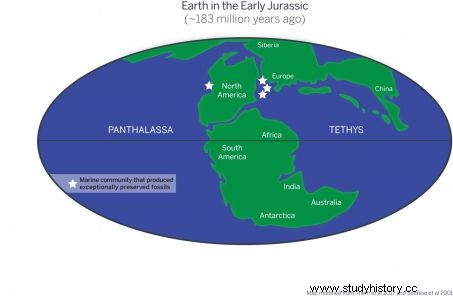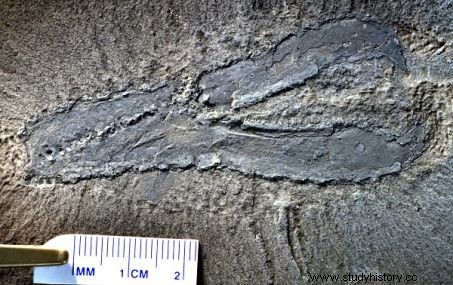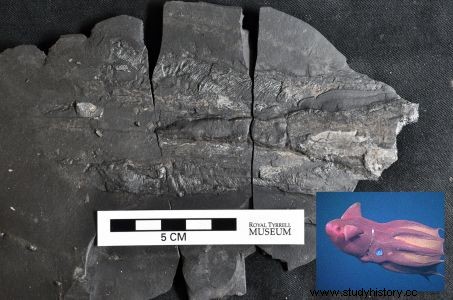A new excavation site discovered in Canada is full of particularly well-preserved Jura fossils.

Fossilized mantle of a cephalopod close to the modern abyssal vampire.
MOUS . It was around Banff National Park, in southwestern Alberta in Canada, that this land was discovered in 2013, housing hundreds of marine fossils dating back approximately 183 million years, i.e. of the Jurassic period. The site is on the way to becoming one of the most important for illustrating the marine fauna of this period because it houses exceptionally well-preserved pieces, including many soft-bodied animals. However, these animals usually escape the processes of fossilization and therefore disappear from the register of life. But when certain conditions are met, they can be preserved. There were only three known sites in the world, all located in Europe, that housed soft fossils from this period, the discovery of this new location will allow paleontologists to have a better idea of the distribution of marine life. , 183 million years ago.

The three European sites and the new one represented on a map from the Jurassic period. Credit:Rowan Martindale and Laura Martin/The University of Texas at Austin Jackson School of Geosciences.
At that time, in fact, the Canadian site and the three Europeans were located on either side of a continent that would later become North America. Two huge oceans (see map above) were home to creatures that were sometimes radically different from modern species and others that seem oddly related to certain current lineages. As evidenced by this fossil reminiscent of an abyssal vampire (in main image), a common cephalopod today. For the past three years, the area has been sifted through every summer by researchers who have already recovered dozens of fossils. Among the most remarkable specimens, they unearthed a kind of lobster with very bulky claws and many other cephalopods.

The lobster-like fossil. Credit:Rowan Martindale/The University of Texas at Austin Jackson School of Geosciences.
"Each time we searched, we discovered something new " rejoices Benjamin Gill, co-author of an article presenting the Canadian site in the journal Geology . "It really is an abundant place " he adds. Scientists will continue to collect material there in order to enrich their collections but also to understand how so many diverse organisms were fossilized together. They believe it is linked to a local extinction of the marine life caused by a very marked decrease in the level of oxygen in certain parts of the oceans, Panthalassa and Tethys, from the Jurassic.

The Vampire Fossil Specimen from the Abyss. Credit:Rowan Martindale/The University of Texas at Austin Jackson School of Geosciences.
